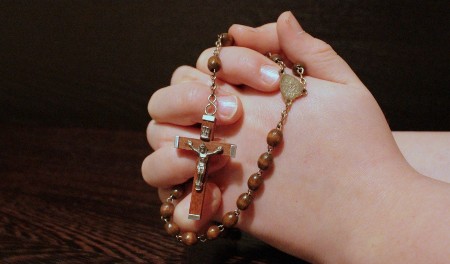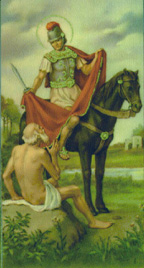We ask you, humbly: don't scroll away.
Hi readers, it seems you use Catholic Online a lot; that's great! It's a little awkward to ask, but we need your help. If you have already donated, we sincerely thank you. We're not salespeople, but we depend on donations averaging $14.76 and fewer than 1% of readers give. If you donate just $5.00, the price of your coffee, Catholic Online School could keep thriving. Thank you.Help Now >
Andrea Contucci del Sansovino
FREE Catholic Classes
Born at Monte San Sovino, Arezzo, 1460; died 1529. He was a sculptor of the transition period at the end of the fifteenth and beginning of the sixteenth century, and showed the qualities of the transition in his style. He worked at first in his native town and in Florence, then for about eight years in Portugal. His best sculptures were produced in Florence and Rome after his return. The "Baptism of Christ", a marble group in the baptistery of Florence, contains very effective figures finely contrasted. The monuments of Cardinals Basso and Sforza Visconti in the Church of Santa Maria del Popolo at Rome are also striking. They prove that he was able to combine what he had fully learned from antiquity with the art of the mature early Renaissance. The central and chief niche stands upon a high pedestal between Corinthian pillars; above the round arch of this niche is an attic, that supports the figure of God the Father upon a shell throne with a genius at each side. In the central niche the dead are represented asleep, their heads resting upon their arms, awaiting resurrection ; above them in the vault of the niche is a figure of the Blessed Virgin, on a smaller scale. In and above side niches are the cardinal virtues, which rise upwards towards the genii just mentioned. The unity in the conception of the structure and the rich decoration of the details show great skill in art. It has been often asserted that there is a touch of the spirit of Raphael in the combination of dignified repose and subdued movement in the figures. Sansovino had a great task given him in the Casa Santa of Loreto, where he was to produce nine reliefs and twenty-two statues. Bramante had encased the Casa with a marble covering, architecturally very fine, which was designed to have rich plastic ornament. Sansovino was only able to make a few of the reliefs, such as the "Annunciation" and the "Birth of Christ", the other reliefs and statuettes were made by his assistants and successors.
Among these pupils was Andrea Tatti (about 1480-1570) of Florence, who took the name of his master Sansovino. During the forty later years of his long life he was, next to Titian, one of the most distinguished artists of Venice. In Venice he represents the second epoch of the grand style in art, and was the head of a clearly defined school. Among his first works were a statue of St. James, at Florence, which, with the exception of a somewhat unnatural pose, has striking qualities, and a Bacchus entirely in the antique style, also at Florence. Among his works at Rome is the celebrated "Madonna del Prato" in the Church of San Agostino. At Venice he adopted a style more akin to painting, which is pleasant in small works, especially if movement and animation are expressed. Among works of this class are the statuettes of Pallas, Apollo, Mercury, Pax, the relief of Phrixos and Helle which adorns the small loggia he built on the campanile, a terra-cotta Madonna, formerly gilded, placed within the campanile, a statue of Hope, and a group containing the Madonna in the palace of the Doges. The colossal statues of Mars and Neptune in front of this palace are less successful. The bronze reliefs around the choir of San Marco, and the bronze doors of the sacristy of the same, however, show pictorial beauty. Sansovino made for the Chapel of St. Anthony at Padua a marble relief in the grand style; it represents the bringing back to life of one who had been drowned, and contains extraordinary contrasts of graceful and repellent figures. As an architect, Jacopo adopted much from the style of Bramante, and in architecture as well as in sculpture brought much of the Roman Cinquecento to Venice. His chief architectural work, the public library, has always been greatly admired on account of its classic form, rich decoration, and wholly pictorial arrangement. It displays a double order of columns, Tuscan and Ionic, over which is a rich frieze and a balustrade with statues. One of his most beautiful decorative works is the small loggia mentioned before. The best of the churches he built is San Georgio de' Greci; it has always been greatly admired for its fine work in marble. Another building of tasteful construction that is ascribed to Sansovino is the Palazzo Corner della Cà Grande. Sansovino gathered about him a large number of assistants, who executed the decorations of the buildings he erected. These buildings were architecturally entirely in accordance with Venetian taste. Thus he was universally regarded in Venice as a master of the first rank, and felt himself completely at home there, although at first he had thought of going to France.
Join the Movement
When you sign up below, you don't just join an email list - you're joining an entire movement for Free world class Catholic education.
-

-
Mysteries of the Rosary
-
St. Faustina Kowalska
-
Litany of the Blessed Virgin Mary
-
Saint of the Day for Wednesday, Oct 4th, 2023
-
Popular Saints
-
St. Francis of Assisi
-
Bible
-
Female / Women Saints
-
7 Morning Prayers you need to get your day started with God
-
Litany of the Blessed Virgin Mary
The Power of the Rosary: Why Praying the Rosary Matters for Catholics
-

Lasers Reveal Hidden Mayan City of Valeriana with 6,500 Structures in Mexico
-

Embracing Peace and Unity in a Time of Division
-
The 'Black Legend': Historian Argues Anti-Catholic Bias in Spanish Conquest Narratives
-
This Catholic Hero Who Fought Against Communism Should Be Released Immediately
Daily Catholic
 Daily Readings for Monday, November 11, 2024
Daily Readings for Monday, November 11, 2024 St. Martin of Tours: Saint of the Day for Monday, November 11, 2024
St. Martin of Tours: Saint of the Day for Monday, November 11, 2024 Prayer for Deceased Veterans: Prayer of the Day for Monday, November 11, 2024
Prayer for Deceased Veterans: Prayer of the Day for Monday, November 11, 2024- Daily Readings for Sunday, November 10, 2024
- St. Leo the Great: Saint of the Day for Sunday, November 10, 2024
- Evening Prayers: Prayer of the Day for Saturday, November 09, 2024
![]()
Copyright 2024 Catholic Online. All materials contained on this site, whether written, audible or visual are the exclusive property of Catholic Online and are protected under U.S. and International copyright laws, © Copyright 2024 Catholic Online. Any unauthorized use, without prior written consent of Catholic Online is strictly forbidden and prohibited.
Catholic Online is a Project of Your Catholic Voice Foundation, a Not-for-Profit Corporation. Your Catholic Voice Foundation has been granted a recognition of tax exemption under Section 501(c)(3) of the Internal Revenue Code. Federal Tax Identification Number: 81-0596847. Your gift is tax-deductible as allowed by law.







 Daily Readings for Monday, November 11, 2024
Daily Readings for Monday, November 11, 2024 St. Martin of Tours: Saint of the Day for Monday, November 11, 2024
St. Martin of Tours: Saint of the Day for Monday, November 11, 2024 Prayer for Deceased Veterans: Prayer of the Day for Monday, November 11, 2024
Prayer for Deceased Veterans: Prayer of the Day for Monday, November 11, 2024

